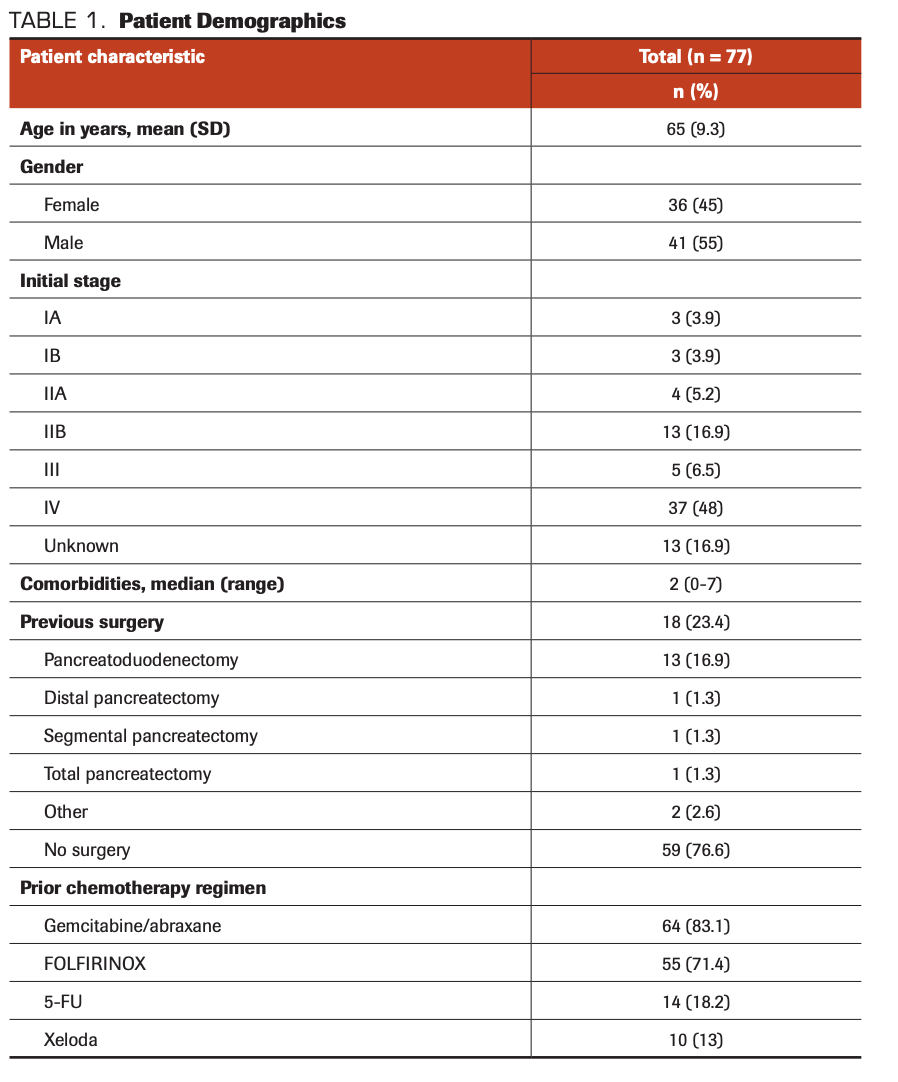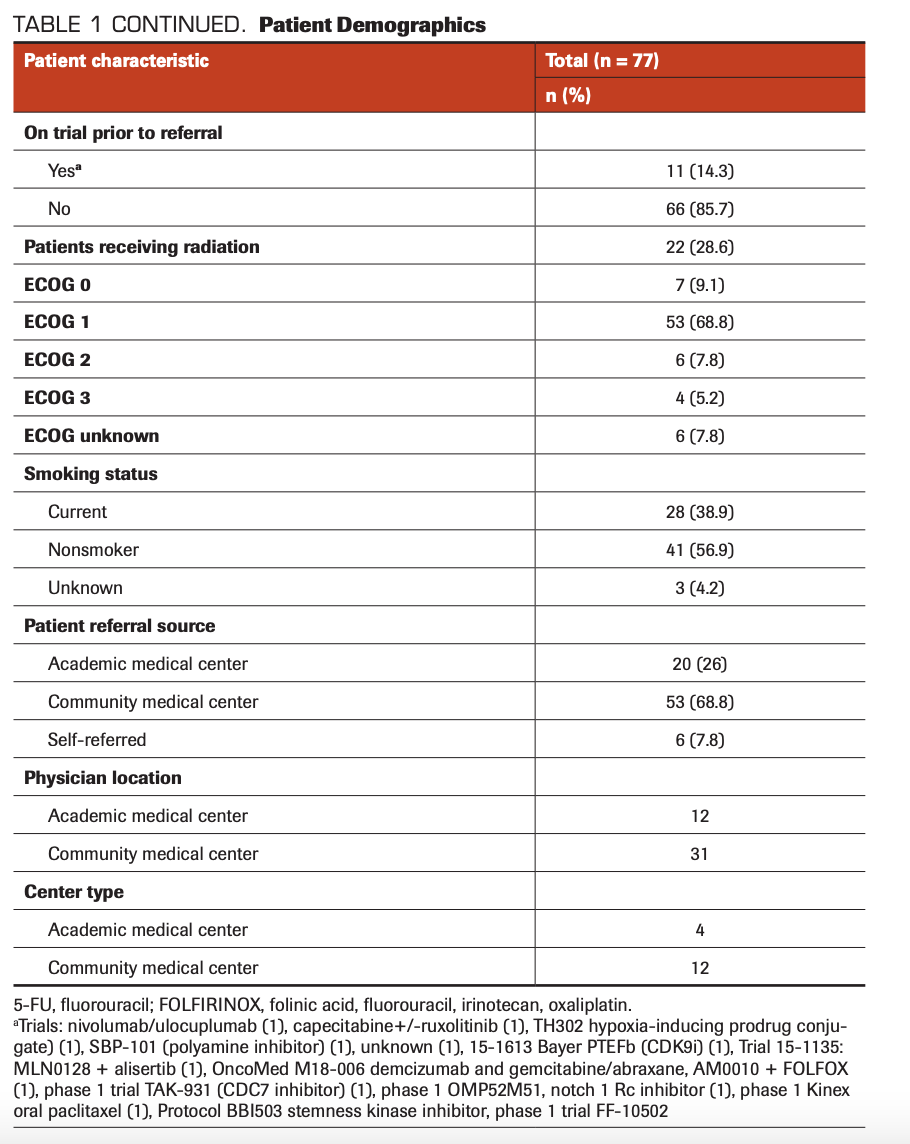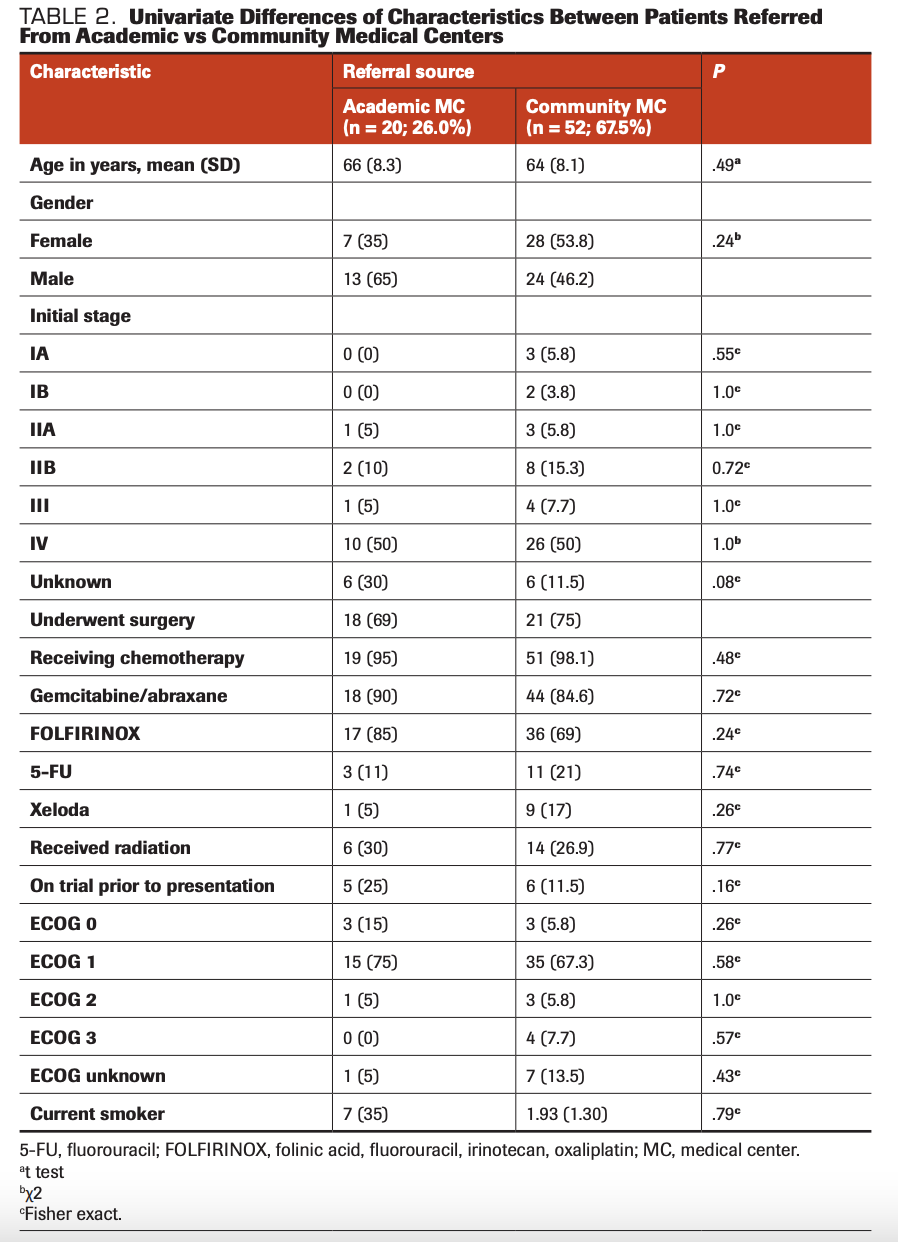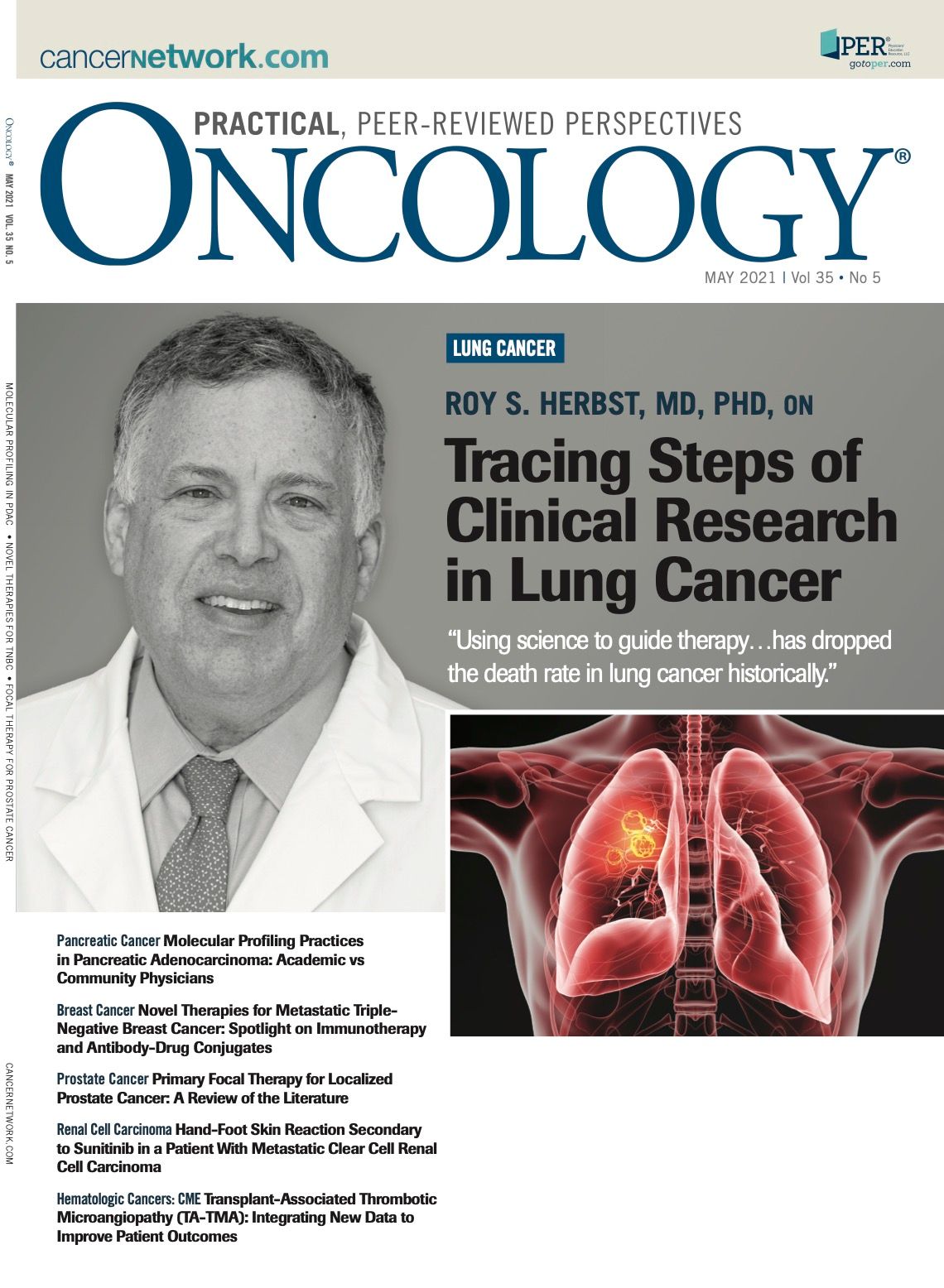Molecular Profiling Practices in Pancreatic Adenocarcinoma: Academic vs Community Physicians
This study published in the journal ONCOLOGY® characterizes molecular profiling practice patterns in individuals with advanced PDAC who were referred to a tertiary clinical trials drug development unit.
ABSTRACT:
Background: Pancreatic adenocarcinoma (PDAC) is relatively rare but highly aggressive, with most patients diagnosed once they have metastatic or locally invasive disease. Molecular profiling is being explored as a tool for selecting patients for targeted therapy clinical trials and for assessing whether targeted therapies may be effective in PDAC. Whether molecular profiling is being performed at both academic and community oncology clinics has yet to be examined. Here, we characterized the molecular profiling practice patterns in patients with PDAC in academic versus community practices in Denver, Colorado.
Methods: We retrospectively reviewed records of all patients with refractory, metastatic PDAC who were referred to a tertiary clinical trials drug development unit in Denver between 2014 and 2019.
Results: Of 77 patients, 41 (55%) were men with a mean age of 65 years (SD, 9.3). Fifty-three patients (69%) were referred from the community and 20 (26%) from academic centers; 4 (5%) were self-referred. A total of 51% received profiling prior to referral; 29 of 50 (58%) were from the community and 10 of 21 (47%) from academic settings. Guardant was the most commonly ordered test (47 of 77; 61%); FoundationOne was the second most common (40 of 77; 52%). Twenty-three of 77 patients (30%) received both Guardant and FoundationOne testing, and 3 of 77 (4%) received Caris MI Profile. One patient received a Mocha assay and another received Ascend/Clarient fluorescence in situ hybridization (FISH). Four patients were self-referred, 2 of whom underwent both Guardant and FoundationOne, 1 who underwent Guardant testing only, and 1 who did not receive any molecular profiling testing.
Conclusions: This study characterizes molecular profiling practice patterns in individuals with advanced PDAC who were referred to a tertiary clinical trials drug development unit. Both academic and community physicians were found to order profiling about 50% of the time. Further research is needed to determine impact on clinical trial enrollment and detection of PDAC.
Oncology (Williston Park). 2021;35(5):244-248.
DOI: 10.46883/ONC.2021.3505.0244
Introduction
Pancreatic adenocarcinoma (PDAC) is the fourth leading cause of cancer death in the United States1 with a 5-year overall survival (OS) rate around 8% in the United States,2 despite years of research and therapeutic development. Current treatment of PDAC is mostly focused on surgical resection for cure. In cases of unresectable or metastatic PDAC, however, chemotherapy has been the only other treatment option outside clinical trials until recently. In the last 15-to 20 years, a large body of transcriptomic and immunophenotypic research has led to the development of numerous targeted therapy–based and immunotherapy-based clinical trial options; subsequently, the first FDA approval of a targeted therapy in advanced PDAC occurred in 2005. With the recent approval of olaparib (Lynparza) for the maintenance treatment of adult patients with germline BRCA-mutated metastatic PDAC, pancreatic cancer treatment has begun to transition from a one-size-fits-all approach to a more precise approach based on genetic variants.3
While tissue-based assays such as FoundationOne CDx remain the mainstay for molecularly characterizing PDAC, newer blood-based platforms have begun to emerge. Guardant360, for instance, molecularly profiles tumors based on circulating tumor DNA that is released into the blood via apoptosis, necrosis, and active secretion.3 Guardant360 can detect EGFR mutations in non–small cell lung cancer (NSCLC); consequently, it became the first FDA-approved liquid biopsy companion diagnostic that uses next-generation sequencing (NGS). The role of molecular profiling in PDAC remains under investigation.
In a retrospective analysis of 1856 patients with pancreatic cancer who were referred to the Know Your Tumor (KYT) program,4 1082 (58%) received personalized reports based on molecular testing results. Only 189 patients had actionable molecular alterations and underwent matched therapies, but these treatments were associated with a significantly longer median OS than that of patients who received only unmatched therapies.4 More recently, the POLO trial5 (NCT02184195) evaluated the efficacy of olaparib as maintenance therapy in patients with a germline BRCA1 or BRCA2 mutation and metastatic pancreatic cancer who had not progressed during first-line platinum-based chemotherapy. The results revealed that progression-free survival was significantly longer in the olaparib group, leading to the first FDA approval for a targeted therapy in BRCA-mutated PDAC with a PARP inhibitor. Because it is FDA approved for all solid tumors, pembrolizumab (Keytruda) is FDA approved for PDAC—specifically, disease with microsatellite instability (MSI) tumors and for disease with high tumor mutation burden.6 Numerous other active studies are examining potential molecular targets of PDAC.
In the past, molecular profiling has been shown to be underutilized in community-based practices. In one study, 292 community oncologists completed a questionnaire to assess how well they understood this technology; about 69% either could not define what molecular profiling was, or answered incorrectly.7 The investigators also found that community-based oncologists use molecular profiling far less frequently than do academic-based oncologists (59 of 292 community oncologists of whom were polled on use of these tests). For example, 33% of community oncologists vs 74% of academic oncologists said they use molecular profiling in treating their patients with lung cancer.7
The aim of our study was to evaluate whether there are differences in molecular profiling practice patterns based on treatment site for individuals with PDAC, a question that has not yet been addressed in the literature. Here, we examined the practice patterns of academic vs community physicians in relation to molecular profiling practices and PDAC in Denver, Colorado.
Methods
We performed a retrospective review of 77 patients with refractory, metastatic PDAC who were referred between August 2014 and May 2019 to the Sarah Cannon Research Institute (SCRI) at HealthONE, an oncology drug development unit in Denver. These patients all had refractory disease after surgical intervention, chemotherapy, and/or radiation therapy. All patients with metastatic PDAC who were referred to SCRI in this period were included.
Patients with PDAC were referred by31 community physicians from 12 different community-based practices and by 12 academic physicians from 4 different academic medical centers (Table 1). As a proxy for identifying academic vs nonacademic practices, we classified each referring oncologist based on whether they are affiliated with a National Cancer Institute–designated cancer center.
TABLE 1. Patient Demographics

TABLE 1 CONTINUED. Patient Demographics

All available data were entered into a Microsoft Excel database (Microsoft Corporation, 2016). A univariate analysis was performed to compare patients who were referred to Sarah Cannon Research Institute (SCRI) from community vs academic medical centers. Patients who “self-referred” (n = 4) were not included in the univariate analysis. This analysis was completed using R Studio (Team, R, 2015). Fisher exact and χ2 tests were used to assess categorical variables; the t test was used for continuous variables. Statistical significance was set at P < .05. This research was approved by the HealthOne HCA institutional review board.
Results
A total of 41 of 77 patients (55%) were men; the mean age of the cohort was 65 years (Table 1). Patients had between 0 and 7 medical comorbidities. Functional status was determined by ECOG performance score (PS), which ranged from 0 to 3; 53% of patients had an ECOG PS of 1. Additionally, 28 of 77 patients (39%) were smokers; 41 (57%) were not and 3 had unknown status (4%). Initial staging varied from stage I to stage IV, and 37 of 77 (48%) were stage IV when referred to our facility. As seen in Table 1, surgical intervention prior to referral occurred in 18 of 77 patients (23%); the surgeries including 13 pancreatoduodenectomies, 1 distal pancreatectomy, 1 segmental pancreatectomy, and 1 total pancreatectomy. Almost all patients (97%; 75/77) underwent chemotherapy prior to referral, which consisted of either gemcitabine and nab-paclitaxel (Abraxane); FOLFIRINOX (folinic acid, fluorouracil, irinotecan, oxaliplatin); fluorouracil; or a combination of these. Eleven patients (14%) participated in some treatment portion of a clinical trial prior to referral and 22 received radiation.
Fifty-three of the 77 patients (69%) were referred from the community and 20 (26%) from academic centers; 4 (5%) were self-referred. A total of 51% received profiling prior to referral; 29 of 50 (58%) were from the community and 10 of 21 (47%) from academic settings. Guardant was the most commonly ordered test (47 of 77; 61%); FoundationOne was the second most common (40 of 77; 52%). Twenty-three of 77 patients (30%) received both Guardant and FoundationOne testing, and 3 of 77 (4%) received Caris MI Profile. One patient received a Mocha assay and another received Ascend/Clarient fluorescence in situ hybridization (FISH). Four patients were self-referred, 2 of whom underwent both Guardant and FoundationOne, 1 who underwent Guardant testing only, and 1 who did not receive any molecular profiling testing. All blood-based molecular tests were ordered between 2013 and 2019.
When we compared patients from community and academic medical centers, we found them to be of similar age, with more male patients being referred from the academic than community settings (65% vs 46%) and more individuals with initial stage being unknown being referred from the academic than community settings (30% vs 11%), although these differences were not statistically significant (Table 2). We also found that a higher percentage of patients referred from academic medical centers (25%) than community medical centers (11%) have previously been part of a clinical trial (Table 2). It’s worth to note that this difference was not statistically significant.
TABLE 2. Univariate Differences of Characteristics Between Patients Referred From Academic vs Community Medical Centers

Discussion
This study analyzes practice patterns and the use of molecular profiling in selection of clinical trials for PDAC, by examining both academic and community oncology practices that refer patients to a tertiary clinical trials drug development unit in Denver. Both academic and community physicians were found to order profiling about 50% of the time. Given that blood-based molecular profiling has become more widely available and supported by more generous patient financial assistance programs only in recent years, it is possible that its use may overtake tissue-based testing in the future. It was just in the past year (August 2020) that Guardant360, a blood-based test, was approved by the FDA as the first liquid biopsy NGS companion diagnostic test for solid tumors.8 All blood-based molecular tests in our study were ordered between 2013 and 2019. During this time, only 40 tissue-based molecular profiling tests were ordered, fewer than the 47 blood-based molecular profiling tests ordered. Moreover, given our understanding of tumor heterogeneity and challenges of limited biopsy samples in advanced PDAC, it remains important to study and validate how concordant or discordant these testing modalities are. Interestingly, blood-based testing was ordered in addition to tissue-based testing in 30% of patients in our analysis. As more patients receive both types of testing, the results may provide insight into answering questions regarding concordance. Ongoing trials are also exploring whether there may be some benefit to ordering repeat molecular profiling at various lines of therapy in order to best understand mechanisms of resistance to anticancer therapies.
Historically, a lack of insurance coverage has often been cited as a barrier to obtaining molecular profiling of an individual’s tumor. Recently, however, CMS has proposed national coverage of diagnostic tests that use NGS technology in patients with recurrent or metastatic solid cancers who have not previously used the test and who wish to pursue further treatment.9 Additionally, the FDA has approved tissue- and blood-based testing as general tumor profiling or as companion diagnostic tests in all solid tumors (but not blood cancers). Specifically, testing is approved in PDAC for BRCA1/2; in NSCLC for EGFR, ALK, and BRAF; in breast cancer for ERBB2; and in colorectal cancer for KRAS and NRAS.10 In our analysis, insurance was a factor in only 1 case in which the provider ordered the test; testing was not performed due to pending insurance approval.
Our study had the notable finding that community and academic oncologists ordered molecular profiling at the same rate—about 50% of the time—a result that is contrary to previous data. As more targeted therapy clinical trials move into the community setting and we continue to see more US FDA approvals for targeted therapies every year, it is possible that community oncologists will continue to perform molecular profiling with the same frequency as academic oncologists.
As mentioned previously, the KYT trial4 was a retrospective study in which patients received personalized reports based on molecular testing results. It was the first step in attempting to understand the application of molecular profiling in PDAC. Only 189 patients had actionable molecular alterations and underwent matched therapies, but these treatments were associated with a significantly longer median OS than that of patients who received only unmatched therapies. Although the KYT trial results showed promising, positive results, multiple potential confounding factors may have affected them. For example, the matched treatment may be effective in prolonging survival itself, or it could be that the presence of an actionable mutation and/or the ability to receive matched treatment might in themselves be a good prognostic factor for better outcomes. Also, the selection of patients who survived long enough to receive 2 different therapies introduced a selection bias toward those individuals with more indolent disease and better prognosis. Additionally, matched therapies were often given in conjunction with chemotherapy, which poses a challenge in attributing the contribution of parts of each therapy to any clinical benefits seen. Moreover, it should be noted that although the results of the KYT trial seemed promising, the adoption of precision medicine for patients with PDAC had no effect on survival for 97.5% of patients. For the 2.5% who could receive a matched treatment, further research by way of randomized clinical trials is warranted to better understand the role of molecular profiling in PDAC.11 Continuing to perform molecular profiling on PDAC tumors will be necessary in order to conduct these clinical trials. Given that less than 10% of those with advanced cancers may have actionable mutations12 as determined by currently available commercial assays, further research is also needed in the discovery of novel targets in PDAC.
Several recent tumor-agnostic approvals have also paved the way for targeted therapy in advanced PDAC. For example, 2 tropomyosin receptor kinase inhibitors—larotrectinib (Vitrakvi) and entrectinib (Rozlytrek)—have recently been FDA approved for NTRK fusion–positive cancers, having demonstrated response rates greater than 75% independent of tumor histology.13 Closely analyzing the real-world data of outcomes with these targeted therapies in PDAC will be critical to understanding their efficacy in this specific indication.
When we compared patients referred for early-phase clinical trials from community and academic medical centers, we found no statistically significant differences in the age, gender, stage at diagnosis, prior treatments, or ECOG PS between the 2 groups (Table 2). Thus, we do not believe there was a clinically relevant confounding variable related to these characteristics that may have influenced why there were no differences in rate of molecular profiling testing.
To date, it is not entirely clear what the correct setting and application of molecular profiling in PDAC is. Continued enrollment into clinical trials will be necessary to answer this question. Similarly, performing molecular profiling on PDAC is needed to generate real-world data on the efficacy of targeted therapies that have been approved in a tumor-agnostic manner and to help identify potential new treatments. Outside of a clinical trial, randomized controlled trials would need to be conducted in order to determine whether molecular profiling in metastatic PDAC is cost-effective and whether it improves survival. Such answers are important, because private and public payers will have to determine how much information is required to establish clinical utility and, subsequently, the tier at which molecular testing continues to be covered.
A main limitation to this study is its retrospective nature and the small sample size of 77 patients. It was also a single-center study, in which most patients were from Colorado. Additionally, only 25% of physicians were from academic institutions, which may reveal inherent bias. Lastly, as all of these patients were referred to our center for clinical trial consideration, they represent only a subset of individuals with PDAC and may be individuals who do not represent the entire population in terms of willingness to receive molecular profiling. The driving factors that underlie why a select group of community oncologists send for molecular profiling and refer patients to a tertiary clinical trials center are unclear at this time. These oncologists may represent a more select group of community physicians who are more inclined to be leaders in molecular-based testing and treatments.
Conclusions
This study analyzes molecular profiling practices in community vs academic centers in Denver, Colorado. Our study demonstrated that community- and academic-based oncologists both ordered molecular profiling in patients with PDAC about 50% of the time. This is contrary to prior data suggesting that academic centers perform molecular profiling more often. Further research is needed to determine how molecular profiling practices may impact treatment selection, clinical trial enrollment, and OS.
Financial Disclosure: The authors have no significant financial interest in or other relationship with the manufacturer of any product or provider of any service mentioned in this article.
Chung is a physician in the Department of Surgery at the Swedish Medical Center in Englewood, CO.
Galvin is a physician in the Department of Surgery at the Swedish Medical Center in Englewood, CO.
Achenbach works with Department of Clinical Oncology Research at the Sarah Cannon Research Institute at HealthONE in Denver, CO.
Dziadkowiec is from the Graduate Medical Education of HCA HealthCare in Denver, CO.
Sen is the associate director of Sarah Cannon Research Institute at HealthONE in Denver, CO.
References
1. Abramson MA, Jazag A, van der Zee JA, Whang EE. The molecular biology of pancreatic cancer. Gastrointest Cancer Res. 2007;1(4 suppl 2):S7-S12.
2. Pihlak R, Weaver JMJ, Valle JW, McNamara MG. Advances in molecular profiling and categorisation of pancreatic adenocarcinoma and the implications for therapy. Cancers (Basel). 2018;10(1):17. doi:10.3390/cancers10010017
3. Malone ER, Oliva M, Sabatini PJB, Stockley TL, Siu LL. Molecular profiling for precision cancer therapies. Genome Med. 2020;12(1):8. doi:10.1186/s13073-019-0703-1
4. Pishvaian MJ, Blais EM, Brody JR, et al. Overall survival in patients with pancreatic cancer receiving matched therapies following molecular profiling: a retrospective analysis of the Know Your Tumor registry trial. Lancet Oncol. 2020;21(4):508-518. doi:10.1016/S1470-2045(20)30074-7
5. Golan T, Hammel P, Reni M, et al. Maintenance olaparib for germline BRCA-mutated metastatic pancreatic cancer. N Engl J Med. 2019;381(4):317-327. doi:10.1056/NEJMoa1903387
6. Leigh M, Lemery SJ, Keegan P, Pazdur R. FDA approval summary: pembrolizumab for the treatment of microsatellite instability–high solid tumors. Clin Cancer Res. 2019;25(13):3753-3758. doi:10.1158/1078-0432.CCR-18-4070
7. Singh BP, Britton SL, Prins P, et al. Molecular profiling (MP) for malignancies: knowledge gaps and variable practice patterns among United States oncologists (Onc). J Clin Oncol. 2019;37(15 Suppl):abstr 10510. doi:10.1200/JCO.2019.37.15_suppl.10510
8. Guardant Health home page. Accessed January 20, 2021. https://www.guardanthealth.com
9. National Cancer Institute home page. Accessed January 20, 2021. https://www.cancer.gov
10. FDA approves blood tests that can help guide cancer treatment. News release. National Cancer Institute; October 15, 2020. Accessed January 20, 2021. https://bit.ly/32f1LQx
11. Tannock IF, Hickman JA. Knowing your tumour? Lancet Oncology. 2020;21(6):e297. doi:10.1016/S1470-2045(20)30283-7
12. Executive summary: interim analysis of the NCI-MATCH trial. National Cancer Institute. May 6, 2016. Accessed January 21, 2021. https://bit.ly/3ddO0HT
13. FDA approves pembrolizumab for first-line treatment of MSI-H/dMMR colorectal cancer. FDA. June 30, 2020. Accessed January 21, 2021. https://bit.ly/32ete4G
